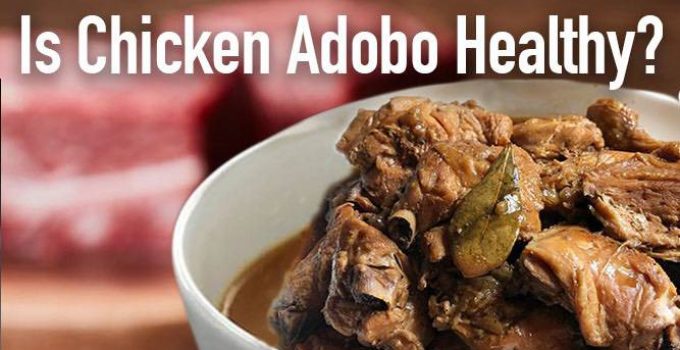Chicken Adobo is a popular dish all over the Philippines. It has become one of the symbols that signifies you grew up in a Filipino household if your ears tingle and your mouth waters when you hear the word adobo.
From regular weekdays, to special occasions and social gatherings, this savory chicken dish is sure to be seen at the center of the table. From our childhood days to our senile days, we are probably not going to stop eating this every once in a while. Which brings us to the question, how does the chicken adobo affect us? Is chicken adobo healthy?
Generally, Chicken Adobo can be a part of a balanced diet but it is not the best choice when it comes to regulating your diet with mostly healthy options since different types of preparing methods involved such as marinating, frying, and boiling result in some loss of nutrients. But there are a number of alternative ingredients you can use to cook chicken adobo which are proven beneficial to your health.
Nutritional Information
The nutritional information, if you don’t know yet, shows what nutrients you get depending on the food that you intake. It is usually measured per serving. It takes a certain amount of nutrients needed per serving for it to be considered beneficial to your health. What kind of food you eat the most will affect your health more, rather than the impact of the specific food you eat at the moment.
According to a research, Filipinos–in general–tend to eat food with more carbohydrates such as white rice, and bread while there is low intake of vegetables, fruits, and dairy, so the intake of vitamins and minerals are also lower as a result. In conclusion, an average Filipino has an inadequate nutrient intake. With this information, you can base your assessment on where you are when it comes to your nutrient intake.
Chicken adobo is also a dish which has relatively low amounts of vitamins and minerals per serving. If you want to know about the complete nutritional information per serving of the Chicken Adobo, here is the list:
Serving: 407g
Calories: 350kcal (18%) | Carbohydrates: 13g (4%) | Protein: 39g (78% ) | Fat: 15g (23%) | Saturated Fat: 3g (19%) | Cholesterol: 178mg (59%) | Sodium: 1458mg (63%) | Potassium: 597mg (17%) | Fiber: 1g (4%) | Sugar: 7g (8%) | Vitamin A: 59IU (1%) | Vitamin C: 3mg (4%) | Calcium: 108mg (11%) | Iron: 2mg (11%)
Adobo’s type of cooking and health implications
Chicken adobo is typically prepared by frying the marinated chicken and boiling. Cooking the food has a large effect on how we intake nutrients. Some methods maximize the nutrient intake of a particular food, while some other methods reduce the amount and quality of certain nutrients. So let’s break down the processes of preparing the chicken adobo and how it affects our nutrient intake.
Marinating is the process where you soak meat in a seasoning liquid that’s usually acidic. Let’s say that the average time we marinate the chicken is overnight, or 24 hours. According to studies, the main effect of this is there is a significant gain in the sodium content of the chicken, and a significant loss in some nutrients such as zinc (loss in nutrients largely depends on what were used for the marinade), at the same time. So the most practical way when marinating meat, is to reduce the amount of salt, and other salty condiments you use when preparing the marinade.
Boiling the chicken, as instructed when preparing chicken adobo, has an effect on what nutrients it retains. It results in a significant loss of nutrients since it is a water-based cooking, and doing this causes the majority of vitamins and minerals to dissolve because these nutrients are water-soluble. A boiled chicken like in adobo loses more B vitamins than other methods of cooking such as roasting the chicken.
Contrary to the loss, the chicken retains more iron, folate, and vitamin E when being boiled. The loss in vitamins, however, is not exactly a waste when you still consume the broth that the adobo produces, since most of them are likely transferred to the cooking liquid.
Some methods of preparing the chicken adobo involve stir frying the chicken, while others prefer to fry the chicken. These are largely different when it comes to the nutrients they retain or lose. Stir frying is actually usually a beneficial method of cooking since it improves the absorption of fat-soluble vitamins. Frying on the other hand, preserves B vitamins and vitamin C, but can mean danger when done in longer periods of time. This results in the production of aldehydes which causes increased risk of cancer and other diseases.
Healthier ingredient substitutes
Choosing the ingredients involved largely affects how beneficial to our health the chicken adobo is going to be. So when picking the products you need, It is important to keep in mind which ingredients will provide the best for your health, especially when you’re being conscious about it.
High Quality Chicken – When choosing the right type of chicken, the ones which are proven to be the most beneficial are the organic, free-range chickens, so choose this rather than other types of chickens. These chickens are the ones who run freely outdoors, and are in control of what they naturally eat, such as worms, seeds, some insects, and plants. This means that they are growing in their own natural way, and are far from toxic chemicals which artificially improve the quality of the chicken.
Balsamic Vinegar – Chicken adobo commonly uses white vinegar for the marinade. While it has the same impact of killing bacteria inside the meat for a safe consumption, other options of vinegar which give more benefits can be used, like this one. This is made out of unfermented grape juice. One of the notable benefits is the active compound acetic acid. It means that there are probiotic bacteria found in this vinegar, which in turn helps maintain a healthy digestion, promote weight loss, and blood circulation.
Ground Papaya Seeds – If these are available near you, it is said that these can be a healthier substitute for the usual black peppercorns that we use as a seasoning for chicken adobo and a number of different dishes. Papaya seeds are a good source of a variety of micronutrients, and they are good antioxidants since they’re high in polyphenols and flavonoids. One more notable thing is these are high in fiber, which help reduce cholesterol levels and regulate blood pressure.
Pin this recipe on Pinterest!
Thank you and I hope you find this article useful! It’ll mean a lot if you SHARE THIS TO YOUR FRIENDS! 🙂



